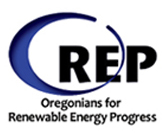Paying for Oregon's Transition to Renewable Energy, July 2011
In the 2011 Oregon legislative session that just ended, Oregonians for Renewable Energy Policy (OREP) made the difficult decision to support the continued use of state energy tax credits for renewable energy production on a temporary basis in order not to lose the public investment Oregonians have already made in creating a renewable energy infrastructure in our state. OREP's support was conditional on the rapid replacement of tax credits for renewable energy with a funding mechanism that does not rely on taxpayer dollars. Instead, Oregonians should pay for clean energy the way we currently pay for dirty energy, through electric rates that pay only for each kWh produced (See OREP's letter to Legislators, June 2011).
As a funding source for renewable energy production Oregon's current energy tax credits have numerous drawbacks.
- Because tax credits are actually uncollected tax dollars, they put renewable energy in competition for scarce tax dollars with state-funded education, public safety and human services;
- Because they require tax liability, tax credits preclude production of clean energy by many would-be participants, such as non-profits like schools and houses of worship and by retired and low-income Oregonians;
- Because Oregon's tax credits pay a lump sum up-front for renewable energy systems rather than for the actual energy produced by those systems, they waste money on unproductive systems; and
- Because the appetite for tax credits varies from year to year with the strength of the economy, their availability is unpredictable, creating uncertainty for investors and instability for the RE industry.
If tax credits were a cost effective method for developing new energy sources, they would have been used historically to develop energy from fossil fuels. When an Oregon utility has needed to build a new coal plant or gas turbine, the capital and fuel costs have been assessed in rates and are paid for over time by electricity customers (i.e., rate-payers not tax-payers).
A funding mechanism that uses ratepayer dollars to pay for clean energy is a feed-in tariff (aka guaranteed pricing structure) for renewables. Feed-In Tariffs guarantee all producers of renewable energy a fixed price per kWh over a set contract period. To date, FITs are responsible for 75% of the world’s solar and 45% of global wind power. FITs are preferable to tax credits in many ways.
- Because FITs pay producers a fixed price per kWh calculated to cover the cost of generation and a reasonable return on investment, all guaranteed over a fixed time period, FITs provide investors certainty and are tremendously effective at attracting private investment in the RE sector.
- Because FIT contracts have a longer payback than Oregon’s energy tax credits (typically 20 years vs. 4-5 years), they make renewable energy more affordable and yield more rapid deployment. In general, the longer the payback period, the more kWh can be produced per year for the same money. Just like the introduction of the 30-year fixed home mortgage spurred rapid growth in home construction in the U.S.. in the last century, countries offering 20-year fixed price contracts for renewable energy (aka FITs) have seen rapid growth in clean energy generation and in their RE industries.
- Because FITs pay for clean energy from electric rates rather than tax dollars, renewable energy does not compete with schools and other state services for general fund monies.
- Because FITs pay only for actual electricity produced, unlike tax credits, which are a subsidy for system equipment, they encourage installation of the most productive systems, generating maximum electricity production per dollar spent.
- Because a FIT program periodically but predictably reduces prices offered to new producers, they drive down the cost of renewable energy technologies over time.
- Because a well-designed FIT provides incentives for producers to maximize production and minimize consumption, it reduces GHG more effectively than tax credits, which are paid whether or not any energy is ever produced and provide no incentives to reduce energy use.
- Because ultimately it is ratepayers, rather than taxpayers, who will see lower costs from increased renewables in Oregon’s energy mix, it is ratepayers who should make the investment.
Thanks to the far-sighted investments in renewable hydropower made by our predecessors in the last century, today’s Oregonians benefit from some of the lowest-cost clean energy in the U.S. Oregon’s current energy mix comprises 60% hydropower. The sooner we convert the remaining 40% fossil fuels to renewables, the sooner Oregon ratepayers will benefit from these essentially free fuel sources.
The long-term fixed price contracts that are the hallmark of effective feed-in tariff programs hold the greatest potential to help Oregon rapidly reach that goal. We should move quickly to develop a comprehensive FIT program for all renewables and all Oregonians both to rapidly generate more renewable energy and create green jobs.


